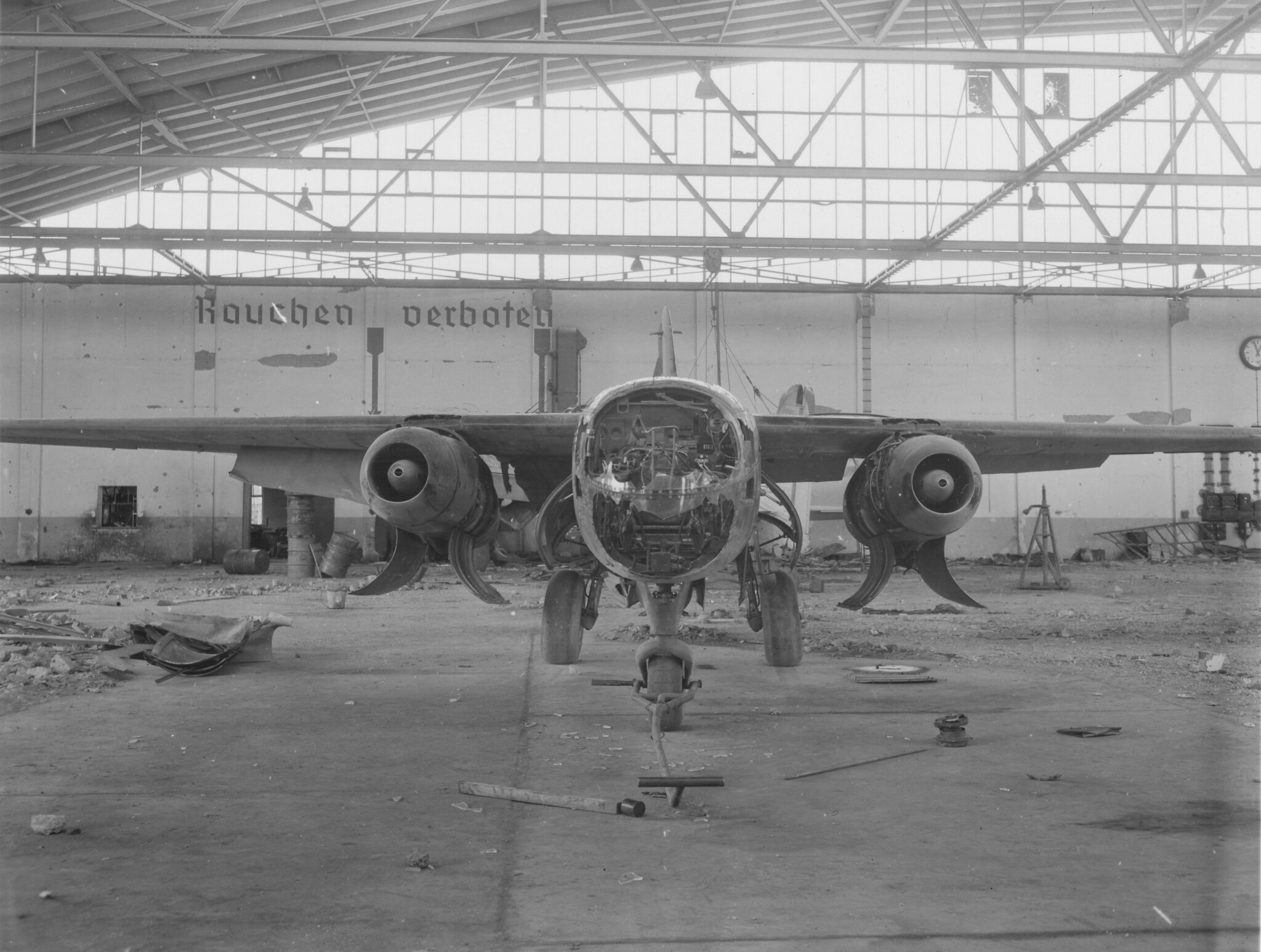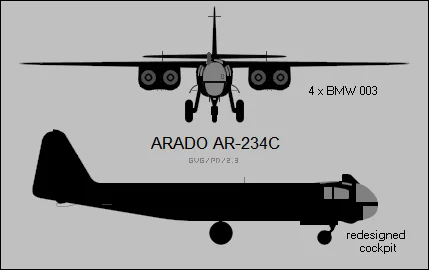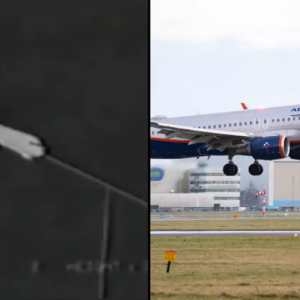Arado Ar 234 – The World’s First Operational Jet Bomber

When it comes to revolutionary aircraft of the Second World War, the Arado Ar 234 Blitz undoubtedly takes a prominent spot.
This German plane, developed by the Arado company, made history as the world’s first operational jet-powered bomber.
With its unique characteristics and impressive performance, it reshaped the concept of aerial warfare, leaving a profound legacy despite its short operational history.
Contents
The E.370 project
The Blitz
Variants
Operational History
Conclusion
The E.370 project
The genesis of the Arado Ar 234 lies in the E.370 project. Initiated in 1940, the E.370 was Arado’s response to the Reichsluftfahrtministerium’s (RLM) call for a high-speed reconnaissance aircraft.
 Out of the E.370 project, the Ar 234 was born. Photo credit – Kogo GFDL.
Out of the E.370 project, the Ar 234 was born. Photo credit – Kogo GFDL.
The project was an ambitious endeavour, aiming to utilize newly-developed jet propulsion technology to create a faster, more efficient, and higher-flying aircraft than anything seen before.
The E.370 prototype was innovative, featuring a sleek, streamlined design and twin engines. It was the groundbreaking blueprint from which the Ar 234 was born.
The Blitz
The Ar 234 was a remarkable piece of engineering. Powered by a pair of Junkers Jumo 004B turbojet engines, it was capable of reaching speeds of up to 740 kilometres per hour, making it one of the fastest aircraft of the war.
 The Ar 234 initially used the Jumo 004 engine.
The Ar 234 initially used the Jumo 004 engine.The Jumo 004 was one of the most important aero-engines of the Second World War and the first turbojet engine to be produced in quantity.
Designed and built by the Junkers Motoren (Jumo) company in Germany, it powered some of the most innovative aircraft of the war, including the Messerschmitt Me 262 and the Ar 234.
The Jumo 004B was a variant of the original 004 models, developed with the intention of improving upon the earlier design.
It was a single-shaft axial-flow turbojet, a relatively new concept at the time.
The engine’s design was relatively simple, partly for ease of manufacture and partly due to materials shortages.
 The Junkers Jumo 004.
The Junkers Jumo 004.
For instance, because of a lack of suitable alloys, the turbine blades were made from steel and coated in aluminium, which limited the engine’s lifespan.
The Jumo 004B produced a maximum thrust of approximately 900 kilograms-force (2,000 pounds-force).
It had an eight-stage axial-flow compressor, six straight-through combustion chambers, and a single-stage turbine.
The engine was started using an electric starter motor, which was relatively unusual for aircraft engines at the time.
Fuel consumption was high, a common problem for early jet engines, which limited the range of aircraft using the engine.
Despite its limitations, the Jumo 004 was an innovative and significant step forward in aviation technology, providing a foundation for the development of more efficient and powerful jet engines in the post-war period.
 An Ar 234 using a similar launching method to the Me 163.
An Ar 234 using a similar launching method to the Me 163.
But, due to the high fuel consumption, it had a maximum range of around 1,630 kilometres. However, the service ceiling of 10,000 meters allowed it to fly higher and farther than most other aircraft of the time.
The Ar 234 was initially designed for reconnaissance, being equipped with cameras but without defensive armament.
However, later variants would include a bomb load of up to 1,500 kilograms.
The aircraft had a unique feature: a jettisonable three-wheel trolley for takeoff, which was discarded once the plane was airborne to save weight, as the aircraft originally had no landing gear.
Later variants included a conventional, retractable tricycle undercarriage.
Variants
The Ar 234A, the initial version, was a high-speed reconnaissance aircraft powered by two Junkers Jumo 004B engines.
It was unique in its design, featuring a jettisonable three-wheeled take-off trolley in lieu of a conventional landing gear, which was left behind after takeoff to save weight, with the aircraft landing on a retractable skid.
The Ar 234A was armed only with cameras, having no defensive or offensive weaponry.
 A silhouette of the Ar 234C.
A silhouette of the Ar 234C.
The 234B was the main production variant and the first model to see operational service.
Compared to its predecessor, the 234B incorporated significant improvements.
The jettisonable trolley was replaced with a conventional, retractable tricycle landing gear.
The cockpit was enlarged to improve visibility, and the aircraft was modified to carry up to 1,500 kilograms of bombs, transforming it from a pure reconnaissance aircraft into a bomber.
However, it retained its reconnaissance capabilities and continued to be used in this role.
The Ar 234C, an ambitious development of the 234B, aimed to increase the aircraft’s performance and payload.
 The BMW 003 was an improvement on the Jumo 004.
The BMW 003 was an improvement on the Jumo 004.
This variant was powered by four BMW 003 turbojet engines instead of the two Junkers Jumo 004s of the earlier versions.
This change in powerplant promised to provide more thrust and to increase the aircraft’s bomb-carrying capacity.
However, due to the complications of the late-war situation in Germany, including shortages of materials and disruptions in production, only a small number of 234Cs were built.
One of the most intriguing variants was the Ar 234P, designed to serve as a night fighter. This variant was equipped with radar equipment and increased armament for the interceptor role.
 There were various modifications put forward. However not many went into production.
There were various modifications put forward. However not many went into production.
The crew was expanded to two, with a radar operator located in a second cockpit.
However, the 234P remained in the experimental stage and never entered production or operational service.
Each of these variants of the Arado Ar 234, despite their different roles and features, shared the common thread of innovation.
They marked significant steps in the use of jet propulsion in military aircraft, paving the way for the future of aviation.
Even though the operational use of the Ar 234 was limited by the circumstances of the war, its variants provide a fascinating insight into the rapid pace of technological development during this intense period of history.
Operational History
The Arado Ar 234 entered service in late 1944, seeing action in both reconnaissance and bombing roles. Its high speed and altitude made it nearly untouchable by Allied fighters and anti-aircraft fire.
The Ar 234 was notably used in the Ardennes offensive (Battle of the Bulge) and in the attempted destruction of the Ludendorff Bridge at Remagen.
 A map showing the German plan during the Battle of the Bulge.
A map showing the German plan during the Battle of the Bulge.One of the more notable missions involving the Ar 234 during the Battle of the Bulge was carried out by Lieutenant Edmond Delaitre, a pilot of the Kommando Sperling unit, which was a special Ar 234 reconnaissance unit.
On December 23, 1944, in poor weather conditions, Delaitre flew a crucial mission over the Ardennes battlefield, obtaining photographs that revealed a gap in the Allied front line near Dinant, Belgium.
The German high command used this information to direct their forces to exploit the weakness, contributing to the initial success of the German offensive.
Although the Ar 234 was technologically advanced, it was too late to significantly affect the outcome of the war.
Only around 210 were built due to a variety of reasons, including the late war situation, shortages of materials, and production difficulties.
Conclusion
In the grand scheme of World War II, the Arado Ar 234 may not have turned the tide of the conflict, but its influence reverberates in aviation history.
As the world’s first operational jet-powered bomber, it set the stage for the jet age, demonstrating the potential of jet propulsion in military aviation.
Despite its limited production and late entry into the war, the Ar 234 stands as a symbol of the rapid technological advancements of the era, a testament to the innovation spurred by necessity, and a precursor to the jet-powered aircraft of the future.
If you like this article, then please follow us on Facebook and Instagram.
Specifications
Crew: 1
Length: 12.64 m (41 ft 6 in)
Wingspan: 14.41 m (47 ft 3 in)
Height: 4.29 m (14 ft 1 in)
Empty weight: 5,200 kg (11,464 lb)
Max takeoff weight: 9,800 kg (21,605 lb)
Powerplant: 2 × Junkers Jumo 004B-1 axial flow turbojet engines, 8.83 kN (1,990 lbf) thrust each
Powerplant: 2 × Walter HWK 109-500A-1 Starthilfe liquid fuelled jettisonable JATO rocket pods, 4.905 kN (1,103 lbf) thrust each (optional)
Maximum speed: 742 km/h (461 mph, 401 kn) at 6,000 m (20,000 ft)
Cruise speed: 700 km/h (430 mph, 380 kn) at 6,000 m (20,000 ft)
Range: 1,556 km (967 mi, 840 nmi) with 500 kg (1,100 lb) bomb load
Service ceiling: 10,000 m (33,000 ft)
Rate of climb: 13 m/s (2,600 ft/min)
News
The “Red Zone” – Land Still Abandoned Due to the Dangers Left by the First World War
The “Red Zone” – Land Still Abandoned Due to the Dangers Left by the First World War In the aftermath of the First World War, large areas of northeast France were left in ruin. Years of constant siege warfare along…
Before Becoming a Big-Name Actor, Richard Todd was a Paratrooper Who Fought at Pegasus Bridge
Before Becoming a Big-Name Actor, Richard Todd was a Paratrooper Who Fought at Pegasus Bridge Photo Credit: 1. Sgt. Christie, No. 5 Army Film & Photographic Unit / Imperial War Museums / Wikimedia Commons / Public Domain 2. Silver Screen…
The Potsdam Giants: A Prussian Infantry Regiment Of Nothing But Very Tall Soldiers
The Potsdam Giants: A Prussian Infantry Regiment Of Nothing But Very Tall Soldiers Frederick William I inspecting his giant guards known as The Potsdam Giants, a Prussian infantry regiment No 6, composed of taller-than-average soldiers. Frederick William I of Prussia,…
Ellen DeGeneres cuts a very casual figure as she drives around in her Ferrari
Ellen DeGeneres cuts a very casual figure as she drives around Montecito in her Ferrari… while preparing to embark on her stand-up tour Ellen DeGeneres cut a very casual figure as she made her way around Montecito on Tuesday morning. The…
“I’m heavily tattooed and keep getting rejected for jobs – it’s not fair”
Heavily tattooed OnlyFans star, 23, with multiple piercings on her FACE slams TJ Maxx for rejecting her for a job – accusing retailer of unfairly judging her dramatic look A woman has accused TJ Maxx of rejecting her for a…
All 75 passengers killed in plane crash after pilot let his chirldren control the plane
Praying, turning the engine off by accident and letting KIDS play with the controls: The worst blunders made by pilots before a crash revealed Every time we board a plane, we put our lives in the hands of the pilot….
End of content
No more pages to load











